Seconded By: Eric Meola,
The United States of America as we know it today was founded through deception and genocide of the Indigenous people who were stewards of this land since time immemorial. “A Sacred Unity” is a collaborative project documenting the Apache Stronghold’s fight to heal from the past by protecting sacred sites, religious freedom, and the environment for future generations.
Since January 2021, I have made countless trips now to Apache sacred sites Oak Flat (Chi’chil Biłdagoteel) and Mt. Graham (Dził Nchaa Si’an), including nearly four months spent living on the San Carlos Apache Reservation with the Nosie family. I’m deeply honored that they opened their home and lives to me, entrusting me with knowledge about the Apache religion, history, and culture that is rarely, if ever, shared with outsiders.
Dr. Wendsler Nosie Sr. is a former chairman of the San Carlos Apache Tribe and the founder of the Apache Stronghold, a nonprofit coalition of diverse people dedicated to protecting Native sacred land from desecration and destruction. Dr. Nosie refers to the movement to protect sacred sites as “a personal journey to a sacred unity.” We have to come together to heal from the past and protect what is left. I never forget the fact that I am white, descended from European immigrants (Austrian refugees, Scottish and Irish settlers). He is a Chiricahua Apache from the Bedonkohe clan, descended from the same band as Geronimo. Together, we are creating a record of the past and present, to be used as a blueprint for the future.
The Apaches are the last prisoners of America’s first war, waged against its Native people. With up to 90% of America’s Indigenous population exterminated through war and disease, those who survived were deceived, imprisoned, and left with broken promises. The cultural genocide against Indigenous people is ongoing.
Apaches famously resisted military domination, and they paid dearly for their effort to keep their independence and ancestral homelands. Though the Apache Wars officially ended in 1886, conflicts extended into the 1920s, with restrictions on tribal members and forced relocation and assimilation of children continuing for decades.
The traditional Apache way of life emphasizes family and spirituality though a tight-knit community, intricately tied to their ancient ceremonies, which include sweat lodge ceremonies for the men and the Sunrise Ceremony, an Apache girl’s coming-of-age. Ceremonies teach essential skills and endurance, which shape individuals and the community. The Apache religion is geocentric, inextricably tied to these specific sacred places for ceremonies and prayer.
Oak Flat, in Tonto National Forest, is under imminent threat from Resolution Copper, a subsidiary of foreign mining giants Rio Tinto and BHP. These companies have a proven track record of human rights violations and environmental destruction across the globe. The proposed mine will decimate this irreplaceable sacred site, leaving a crater two miles wide and a thousand feet deep, and an environmental disaster behind. Congress exempted Resolution Copper from all federal environmental law, so once the land is transferred, there won’t be any restrictions or oversight of the mine’s activity, setting a dangerous precedent. Other corporations are lining up already to request similar exemptions.
In early 2021, the Apache Stronghold filed a lawsuit against the United States, aiming to protect Oak Flat by forcing the government to honor the Apaches’ right to freely practice their religion on their sacred ancestral homelands. The lawsuit also cites a treaty from 1852 which never transferred Oak Flat to the United States; it is still Apache territory.
In an unprecedented move, the federal court allowed Resolution Copper to join the US in the lawsuit in May 2023, so foreign corporations are now fighting alongside the United States against their Indigenous people.
In March 2024, following a rare en banc hearing in front of a panel of 11 judges, the 9th Circuit Court of Appeals ruled 6-5 against the Apache Stronghold. This summer, their appeal will be filed with the US Supreme Court.
My photographs focus on the Apache Stronghold’s outreach work, prayer runs, religious ceremonies, and daily life on the reservation. I collaborate closely with Dr. Nosie to ensure accuracy. I’m deeply grateful for his guidance and vision. Every piece of this project is undertaken with his support, often at his request.
The Apache Stronghold’s message is resonating deeply with people across the country, as they work towards a future where the environment and all religions are protected for generations to come. America is fractured today because the foundation, its base, is not solid. By reckoning with the past, there is hope for healing as we work collectively towards a better future.
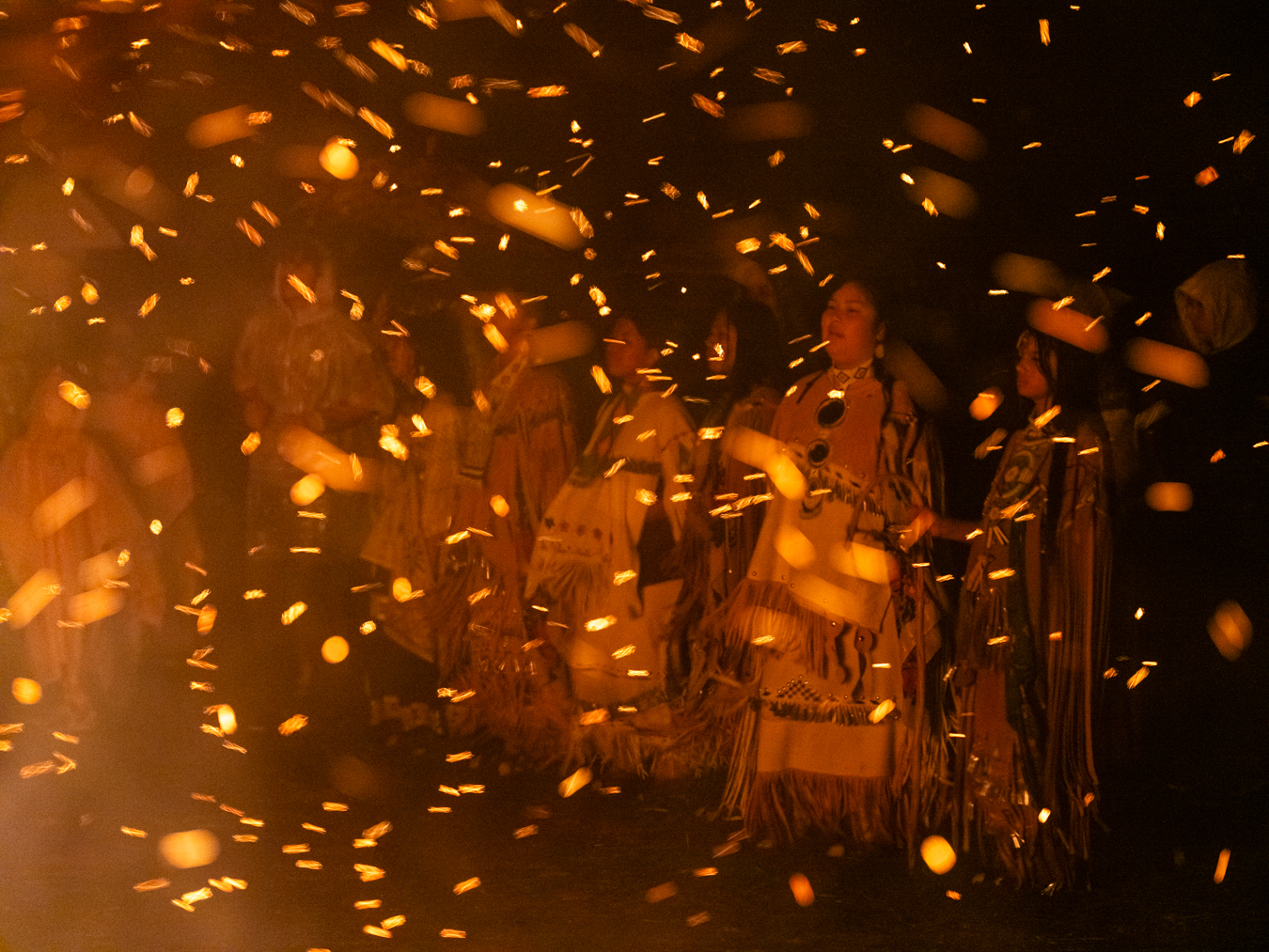
Sparks from the bonfire fly through the air as Sage Parsons, her ceremony partner Aleigha Nosie, and other girls chosen to participate, dance on Saturday night during Sage’s Sunrise Ceremony, waiting for the Ga’an People (embodied by the Crown Dancers). Once they arrive, the girls will dance with them around the fire, which symbolizes the core of the earth.
July 24, 2021.
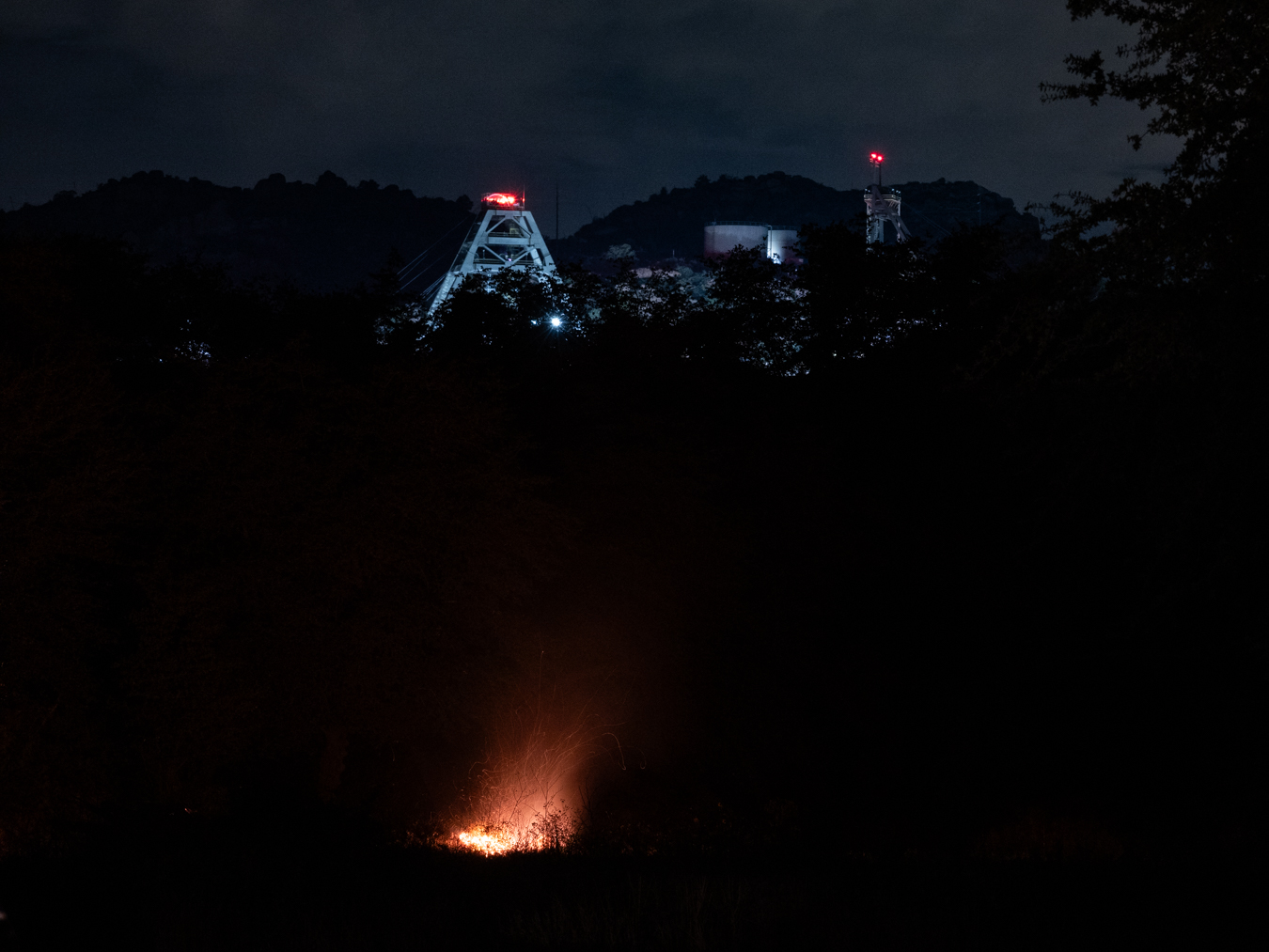
The bonfire during a Sunrise Ceremony at Oak Flat burns bright beneath the mine on October 6, 2023. The existing Resolution Copper mine on the border of Oak Flat is already dewatering and contaminating the area, though the damages by the proposed new mine will be exponentially worse: done with a different mining technique, called block cave mining, which will result in a crater over two miles wide and a thousand feet deep, permanently decimating this sacred site. Over 180 degrees will rise to the Earth’s surface, leading to an estimated average 10-degree increase in temperature in a 50 mile radius in an area already plagued by drought and extreme heat, which includes the Phoenix metro area.
No facility in the United States is prepared to process the copper ore extracted by the mine, so it would be shipped to China via Mexico, with only 25% of the copper ever expected to return to the United States. The government is giving away resources to foreign corporations in the name of so-called “green energy,” neglecting to act in the best interest of the health of the land and its occupants long-term. The mine estimates a 40-year production schedule; after the copper is mined, the land will be destroyed forever.
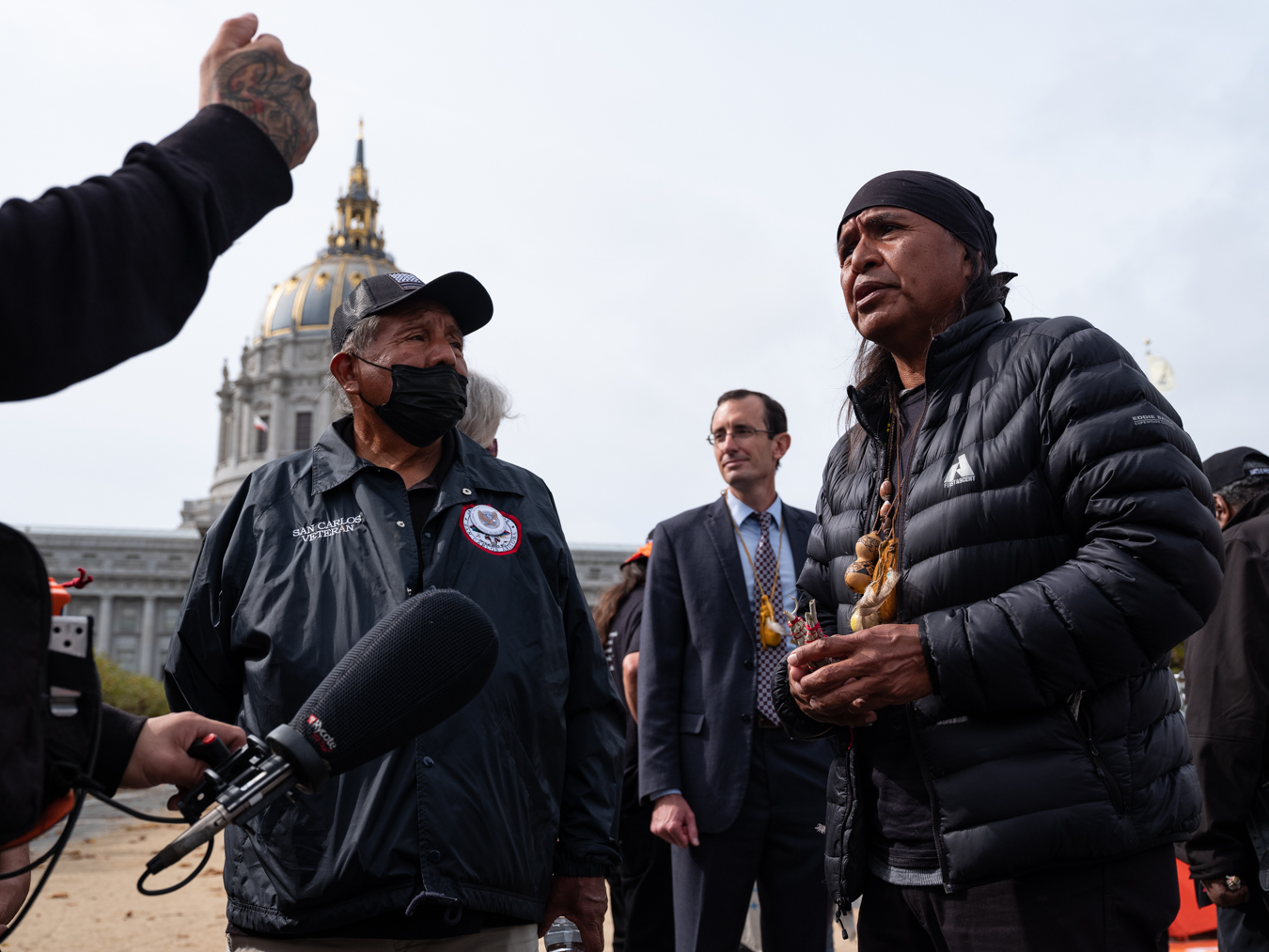
Dr. Wendsler Nosie Sr (right) speaks with the press in front of the San Francisco City Hall, following the Apache Stronghold’s first hearing at the 9th Circuit Court of Appeals on October 22, 2021. The Apache Stronghold’s lawyer through the Becket Fund for Religious Liberty, Luke Goodrich, stands behind. Cranston Hoffman, a traditional prayer warrior, is on the left.
The Apache Stronghold makes spiritual journeys to each court date to connect with tribes and other allies, receiving blessings along the way. Dr. Nosie considers the fight for their religion to be the last battle facing all Indigenous people.
With the lawsuit now heading for the Supreme Court, religious groups and churches representing diverse denominations, major national labor unions, tribes, and other groups across the country have signed amicus briefs in support of the Apache Stronghold’s case. The National Congress of American Indians (NCAI), which is made up of leaders from 146 tribal nations, recently passed a resolution unanimously affirming their support.

Dr. Wendsler Nosie Sr. sings an ancient Apache song after praying at the edge of Ga’an Canyon. This canyon is one of the sacred places at Oak Flat, where the Apache believe the Ga’an People, or angels, travel. White settlers named it “Devil’s Canyon,” encoding their deep prejudice against native religion into the name.
Dr. Nosie regularly reminds audiences that at 65, he’s “first-born reservation,” since San Carlos did not become a reservation officially until the 1930s. His parents were born as prisoners of war in a concentration camp; his great-grandfather was captured by the United States military only a month after Geronimo was sent to Fort Sill as a prisoner. The original prisoner-of-war camp in Old San Carlos, known as “Hell’s Forty Acres,” was chosen for its harsh desert climate. Surrounding mesas housed snipers who would shoot any Apache who attempted to leave. Today, remnants of military barracks are still visible. Many Apaches I’ve spoken with, including Dr. Nosie, still identify themselves as prisoners of war.
March 30, 2023
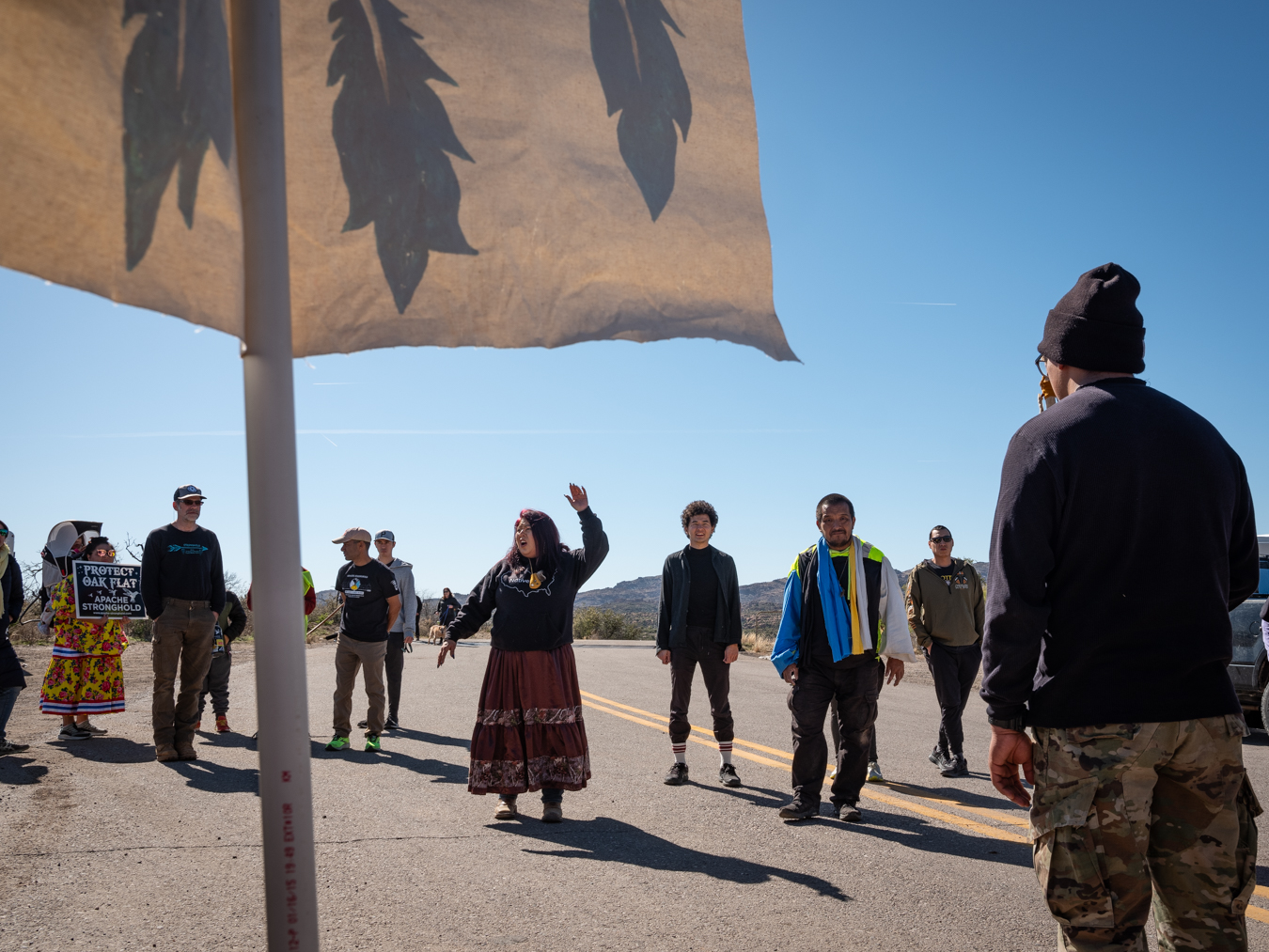
Vanessa Nosie greets runners at the entrance to the Oak Flat Campground when they arrive after completing the roughly 51-mile journey between Old San Carlos and Oak Flat during the 9th Annual Oak Flat Sacred March/Run.
February 18, 2023.
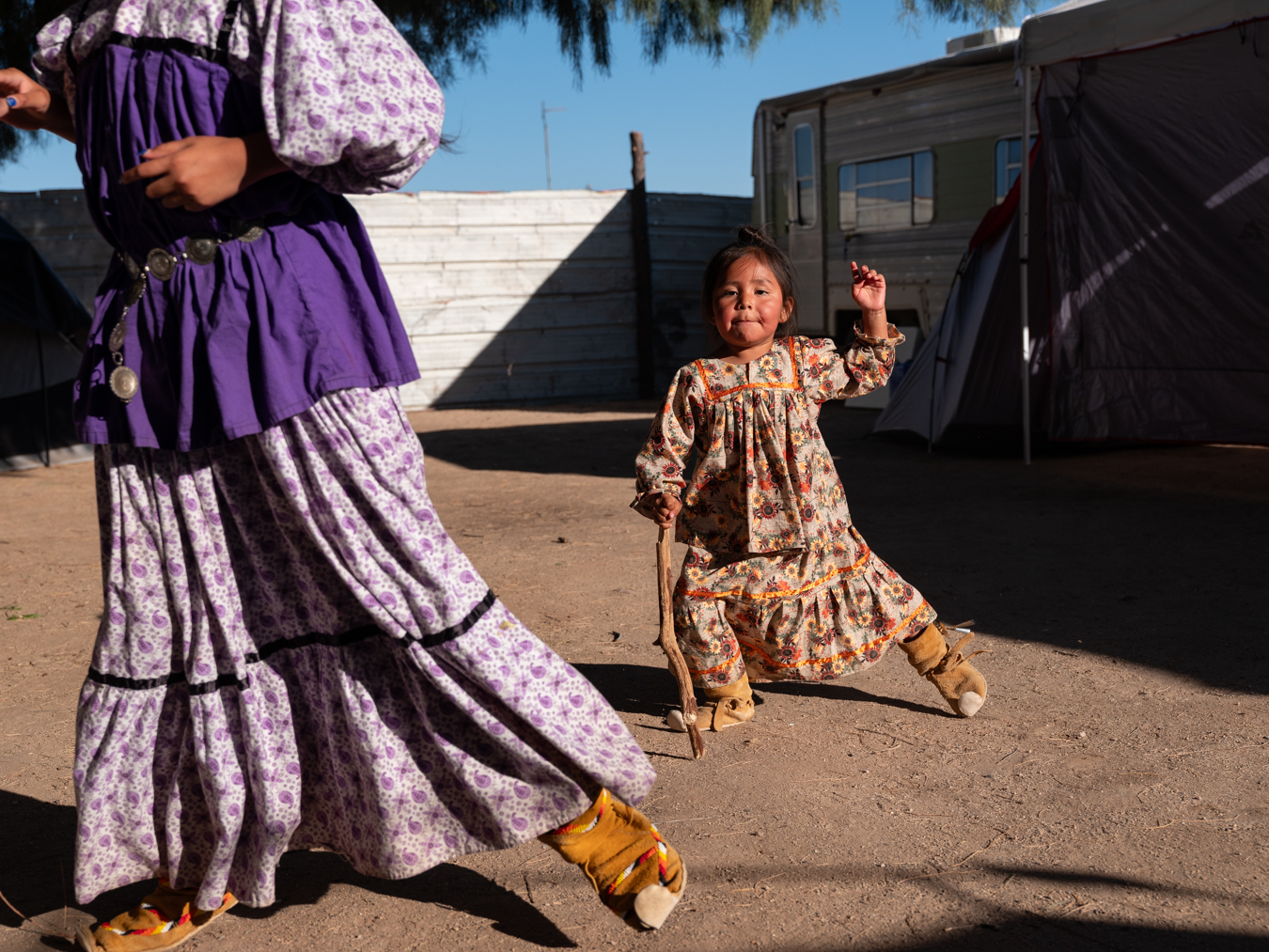
Juniper Grey, age 3, follows her cousin, Lozen Brown, 8, through the major aspects of the sunrise ceremony, play-acting all the roles along the way. Here they are pretending to follow the Ga’an People (Crown Dancers) as they dance around the bonfire. Apache girls prepare for their Sunrise Ceremony throughout their childhood, until it’s time for their own at the onset of puberty.
April 2, 2022.

Bear stands under the remnants of a double rainbow on the San Carlos Apache Reservation. Bear was given to Paul Nosie Jr by his daughter’s fiancé as part of her traditional Apache wedding ceremony.
March 29, 2022.

Much of July 2021 was occupied with preparation for Dr. Wendsler Nosie Sr.’s granddaughter Sage’s Sunrise Ceremony. The Sunrise Ceremony, which marks an Apache girl’s coming of age, is a physically strenuous process where she spiritually transitions into a woman. Though the ceremony itself lasts four days, the family’s preparation for it begins the moment a girl is born.
Here Dr. Nosie and Tyler Patten, a close family friend, take down meat to be cut on July 7, 2021. The previous day, the family butchered a cow to feed everyone at the upcoming ceremony. Signs from a past ceremony and one of Dr. Nosie’s political campaigns were used to keep the family’s dogs away from the meat as it hung overnight to drain.
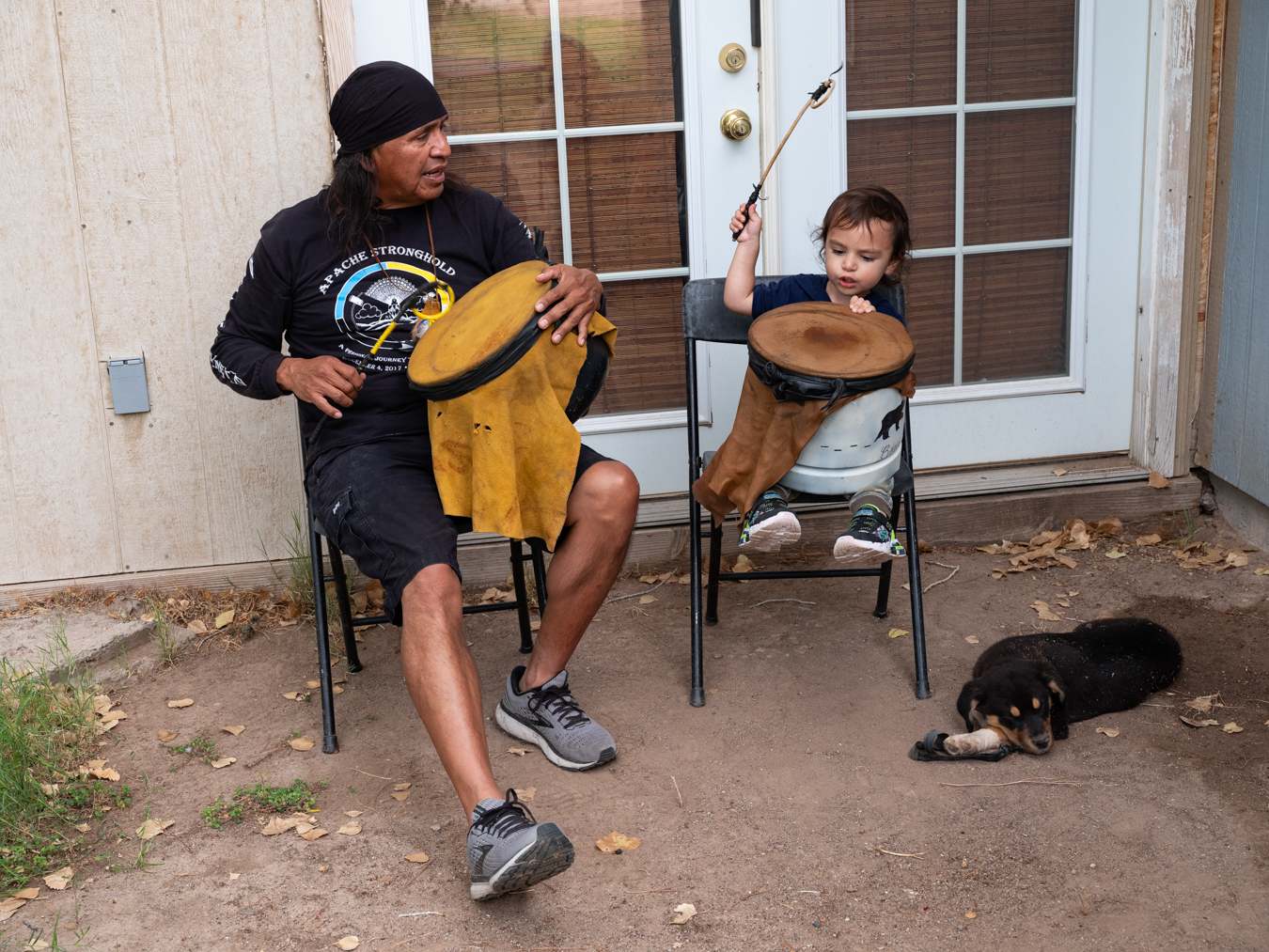
Early in the morning, Dr. Wendsler Nosie Sr. sings and drums with his grandson, RonJon Parsons, outside the family’s house in San Carlos, offering prayer as RonJon’s older sister, Sage, grinds corn nearby in preparation for her Sunrise Ceremony.
July 2, 2021.
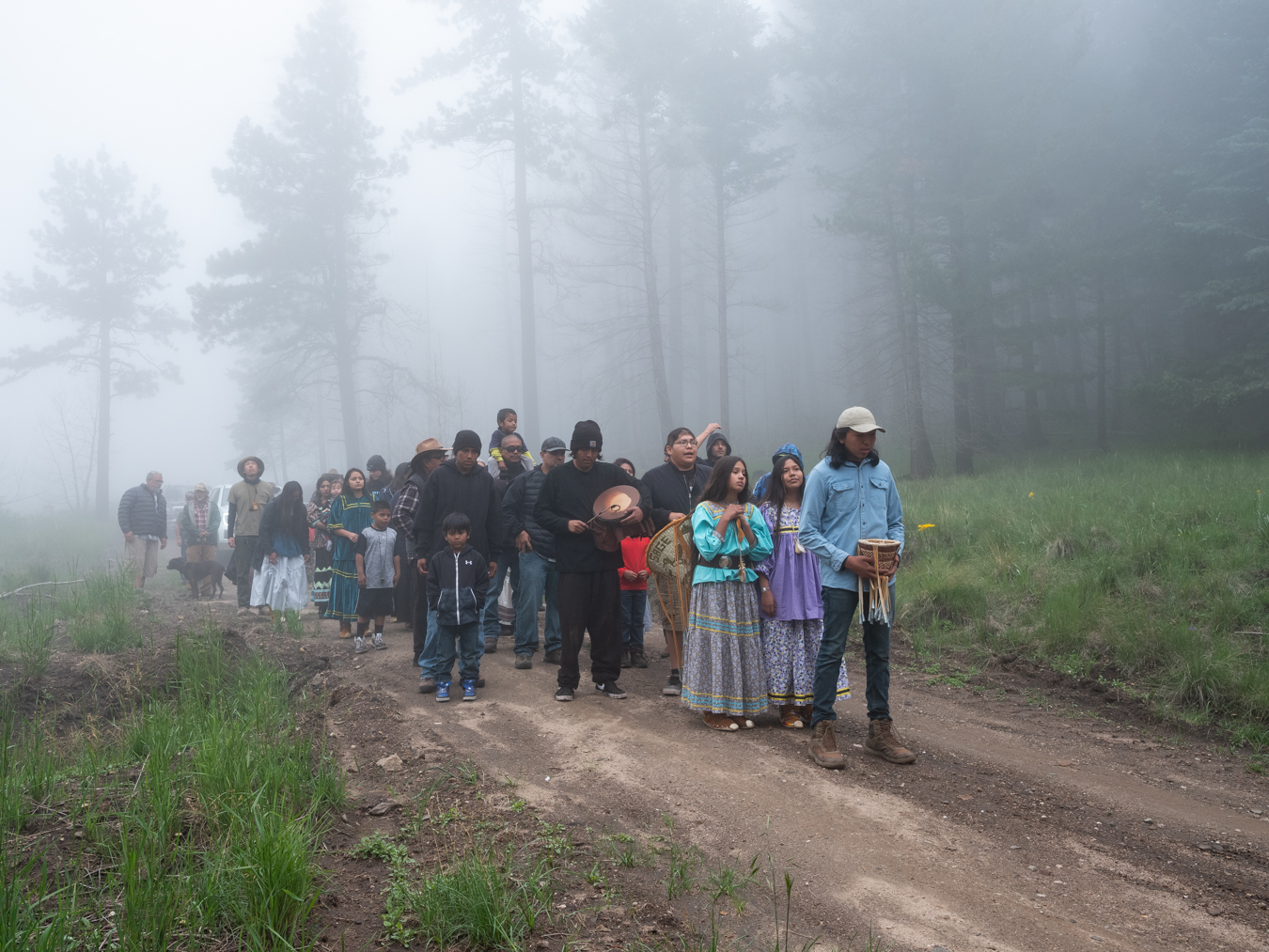
Sage Parsons, Dr. Wendsler Nosie Sr’s granddaughter, had her Sunrise Ceremony in Treasure Park on Mt. Graham in July 2021. After the Apaches were exiled from their ancestral homelands and imprisoned on the reservation, they were not allowed to access their sacred sites for their ceremonies. Naelyn Pike, Dr. Nosie’s eldest granddaughter, was the first Apache girl to have her Sunrise Ceremony on Mt. Graham in over 150 years. Her sister, Baase Pike, was the second, and Sage was the third. On the first day of the four-day ceremony, each camp – the girl’s family, and the godparents’ family – bring food to the sweat to feed the medicine man and others taking part in the ceremony.
July 23, 2021.

